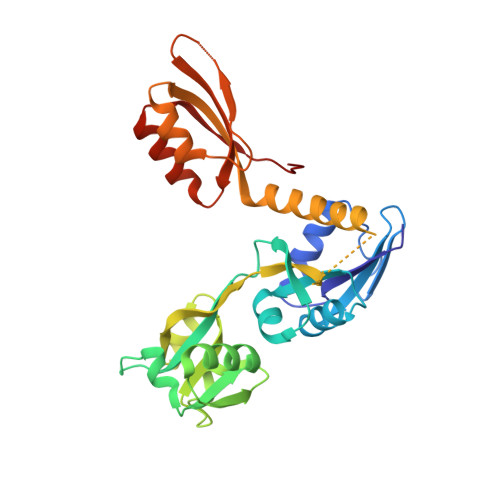Transition State Analysis of Adenosine Triphosphate Phosphoribosyltransferase.
Moggre, G.J., Poulin, M.B., Tyler, P.C., Schramm, V.L., Parker, E.J.(2017) ACS Chem Biol 12: 2662-2670
- PubMed: 28872824
- DOI: https://doi.org/10.1021/acschembio.7b00484
- Primary Citation of Related Structures:
5U99 - PubMed Abstract:
Adenosine triphosphate phosphoribosyltransferase (ATP-PRT) catalyzes the first step in histidine biosynthesis, a pathway essential to microorganisms and a validated target for antimicrobial drug design. The ATP-PRT enzyme catalyzes the reversible substitution reaction between phosphoribosyl pyrophosphate and ATP. The enzyme exists in two structurally distinct forms, a short- and a long-form enzyme. These forms share a catalytic core dimer but bear completely different allosteric domains and thus distinct quaternary assemblies. Understanding enzymatic transition states can provide essential information on the reaction mechanisms and insight into how differences in domain structure influence the reaction chemistry, as well as providing a template for inhibitor design. In this study, the transition state structures for ATP-PRT enzymes from Campylobacter jejuni and Mycobacterium tuberculosis (long-form enzymes) and from Lactococcus lactis (short-form) were determined and compared. Intrinsic kinetic isotope effects (KIEs) were obtained at reaction sensitive positions for the reverse reaction using phosphonoacetic acid, an alternative substrate to the natural substrate pyrophosphate. The experimental KIEs demonstrated mechanistic similarities between the three enzymes and provided experimental boundaries for quantum chemical calculations to characterize the transition states. Predicted transition state structures support a dissociative reaction mechanism with a D N *A N ‡ transition state. Weak interactions from the incoming nucleophile and a fully dissociated ATP adenine are predicted regardless of the difference in overall structure and quaternary assembly. These studies establish that despite significant differences in the quaternary assembly and regulatory machinery between ATP-PRT enzymes from different sources, the reaction chemistry and catalytic mechanism are conserved.
- Maurice Wilkins Centre, Biomolecular Interaction Centre and Department of Chemistry, University of Canterbury , P.O. Box 4800, Christchurch 8140, New Zealand.
Organizational Affiliation:



















